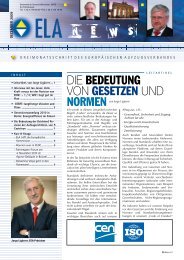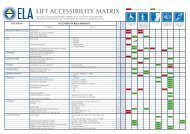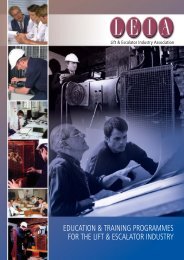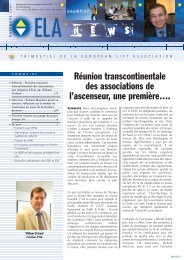WP6-Brochure-E4 brochure - ELA European Lift Association.
WP6-Brochure-E4 brochure - ELA European Lift Association.
WP6-Brochure-E4 brochure - ELA European Lift Association.
You also want an ePaper? Increase the reach of your titles
YUMPU automatically turns print PDFs into web optimized ePapers that Google loves.
30 Optimise traffic handling and management<br />
Optimising traffic handling and management can be both relevant for single installations as<br />
well for groups of installations. For lift groups energy consumption can be reduced by putting<br />
one or more installations into a sleep or deep‐sleep mode during periods with low traffic, for<br />
example, during night time or at weekends, thus reducing or completely avoiding stand‐by<br />
losses.<br />
Recommendation: check possibilities to use or switch off lifts and to optimise traffic<br />
handling.<br />
Relevance: new and retrofit installations where more than one transportation system is<br />
available.<br />
31 Check benefits of using condition monitoring<br />
Modern technological solutions such as condition monitoring provide the possibility to check<br />
the state of operation of a lift. Irregularities in the mode of operation can also indicate<br />
problems that affect the energy efficiency of the installation.<br />
Recommendation: check benefits to use condition monitoring and to include information on<br />
energy consumption.<br />
Relevance: new installations and retrofits.<br />
6.5.7. Features specific to energy‐efficient escalators<br />
Escalators are primarily found in locations operated by owners who have dedicated experts for<br />
energy issues (for example, commercial shopping centres or public traffic infrastructure). The<br />
running time of escalators is usually much longer than that of most lifts. A number of aspects<br />
concerning both lifts and escalators have already been discussed in section 7.3.1. Table 7‐9 and<br />
Table 7‐10 presents additional aspects specific to escalators.<br />
Table 7‐9. Energy efficiency: Escalator drive system<br />
1 Use high efficiency & properly sized motor<br />
Drive system<br />
As with lifts, the drive motors in escalators plus the hand rail motor should be selected from<br />
the most energy‐efficient motors. This is relevant for both the main motor for moving the stairs<br />
as well as the hand rail drive. In addition, a motor should be chosen that also provides a good<br />
efficiency ratio when running outside the nominal point of operation.<br />
Recommendation: motors should be chosen to have a high efficiency both in terms of full load<br />
efficiency, but also in terms of part‐load efficiency.<br />
Relevance: relevant for new installations and (larger) retrofits.<br />
2 Check for adequate gearing<br />
As in geared lifts, gears are used in escalators to transform a torque‐speed ratio.<br />
Recommendation: gearing in escalators should be very efficient due to the high share of<br />
running time. Planetary, helical and hypoid helical gears can for example reach higher<br />
efficiencies than worm gears (see Chapter 3).<br />
Relevance: relevant for new installations but also for (larger) retrofits.<br />
3 Check benefits of using variable speed drives / low speed mode / stop mode<br />
When using a variable speed drive, the speed of the escalator can be reduced until the next<br />
114

















